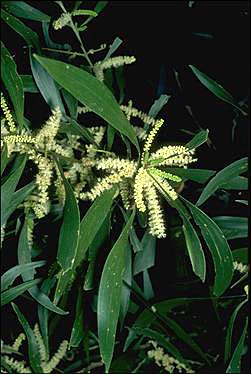Acacia maidenii
Acacia maidenii, commonly known as Maiden's wattle, is a tree species in the family Fabaceae. It is native to Australia, specifically in the states of New South Wales, Victoria, and Queensland. The species is named after Joseph Maiden, a renowned Australian botanist.
Description[edit | edit source]
Acacia maidenii is a medium to large tree that can grow up to 15 meters tall. The bark is smooth and grey, with older stems becoming rough and longitudinally fissured. The leaves are dark green, narrow, and elongated, with a length of 7-12 cm and a width of 1-3.5 cm. The flowers are small, yellow, and arranged in globular clusters.
Distribution and Habitat[edit | edit source]
Acacia maidenii is widely distributed in eastern Australia, from the Hunter River in New South Wales to southern Queensland. It is also found in the coastal regions of Victoria. The species prefers well-drained soils and is commonly found in open forests and woodlands.
Uses[edit | edit source]
The bark of Acacia maidenii contains a high concentration of alkaloids, including dimethyltryptamine, which has been used in traditional medicine and spiritual practices. The tree is also used for timber and as an ornamental plant due to its attractive foliage and flowers.
Conservation[edit | edit source]
Acacia maidenii is not currently listed as threatened under the Environment Protection and Biodiversity Conservation Act (EPBC Act). However, like many native Australian species, it faces threats from habitat loss due to land clearing and urban development.
See Also[edit | edit source]
References[edit | edit source]
Search WikiMD
Ad.Tired of being Overweight? Try W8MD's physician weight loss program.
Semaglutide (Ozempic / Wegovy and Tirzepatide (Mounjaro / Zepbound) available.
Advertise on WikiMD
|
WikiMD's Wellness Encyclopedia |
| Let Food Be Thy Medicine Medicine Thy Food - Hippocrates |
Translate this page: - East Asian
中文,
日本,
한국어,
South Asian
हिन्दी,
தமிழ்,
తెలుగు,
Urdu,
ಕನ್ನಡ,
Southeast Asian
Indonesian,
Vietnamese,
Thai,
မြန်မာဘာသာ,
বাংলা
European
español,
Deutsch,
français,
Greek,
português do Brasil,
polski,
română,
русский,
Nederlands,
norsk,
svenska,
suomi,
Italian
Middle Eastern & African
عربى,
Turkish,
Persian,
Hebrew,
Afrikaans,
isiZulu,
Kiswahili,
Other
Bulgarian,
Hungarian,
Czech,
Swedish,
മലയാളം,
मराठी,
ਪੰਜਾਬੀ,
ગુજરાતી,
Portuguese,
Ukrainian
Medical Disclaimer: WikiMD is not a substitute for professional medical advice. The information on WikiMD is provided as an information resource only, may be incorrect, outdated or misleading, and is not to be used or relied on for any diagnostic or treatment purposes. Please consult your health care provider before making any healthcare decisions or for guidance about a specific medical condition. WikiMD expressly disclaims responsibility, and shall have no liability, for any damages, loss, injury, or liability whatsoever suffered as a result of your reliance on the information contained in this site. By visiting this site you agree to the foregoing terms and conditions, which may from time to time be changed or supplemented by WikiMD. If you do not agree to the foregoing terms and conditions, you should not enter or use this site. See full disclaimer.
Credits:Most images are courtesy of Wikimedia commons, and templates, categories Wikipedia, licensed under CC BY SA or similar.
Contributors: Prab R. Tumpati, MD

